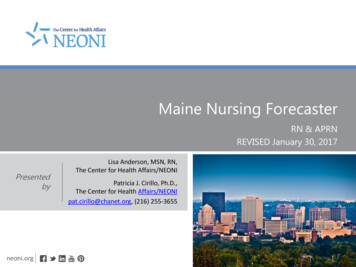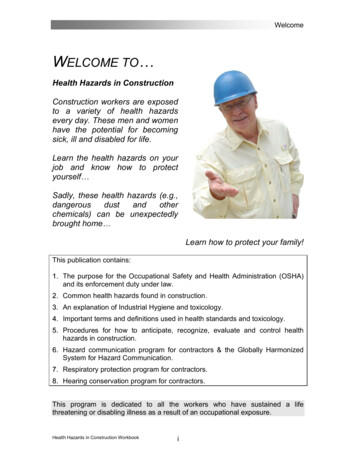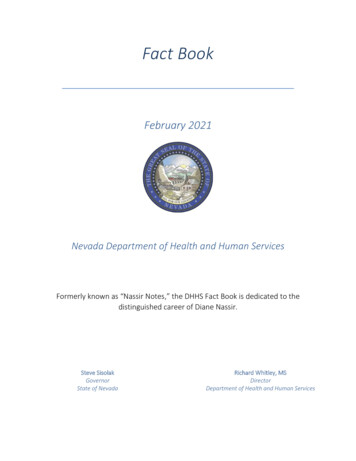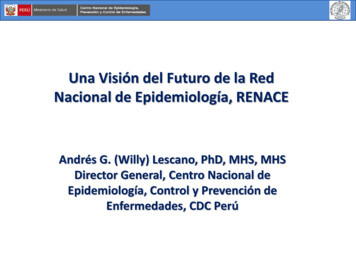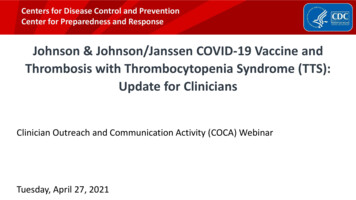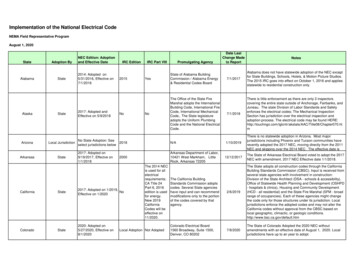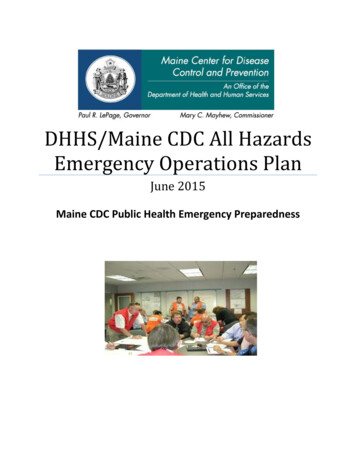
Transcription
DHHS/Maine CDC All HazardsEmergency Operations PlanJune 2015Maine CDC Public Health Emergency Preparedness
Approval and Implementation DocumentState of MaineDepartment of Health and Human ServicesMaine Center for Disease Control and PreventionAll Hazards Emergency Operations PlanThis Plan is hereby approved for implementation.This Plan supersedes any and all previous editions.Kenneth Albert, RN, Esq.Director and COOMaine Center for Disease Control and Prevention6/3/15Datei
DHHS/Maine CDC All Hazards Emergency Operations PlanRecord of Changes to Base PlanDate ofRevision6/11/156/11/15Recommended ChangeEdits to the Base Plan received from Ken Albert DirectorMaine CDC; edits were primarily grammatical, punctuation,font or spelling out acronyms; substantive content changesinclude: several instances of clarification regarding thereporting relationship to the DHHS Commissioner on pp.15, 18, 19, 20, 26, 58, 59; adding the new position of ChiefHealth Officer to the IRT p.14; noting that a listing of MaineCDC MOUs is also now available in the office of theDirector of the Maine CDC.Edits to the COOP received from Ken Albert, Director ofMaine CDC; few basic editing issues; requested “Go KitChecklist” as appendix (see page 6)(TBD); a recommendedactivation of the COOP by the IRT will be approved by theDirector of the Maine CDC p.7; Division of Licensing andRegulatory Services added to the list of partners to benotified re: COOP activation and related continuity issues p.9.RevisionNumber1Initials1JWCJWCii
DHHS/Maine CDC All Hazards Emergency Operations PlanRecord of DistributionTo Whom: Person/Title/AgencyMethod of DeliveryDateiii
Table of ContentsSection I Base Plan11IntroductionPurposeScopeRoles and ResponsibilitiesSituation OverviewPlanning AssumptionsVulnerable Populations Access and DemographicsConcept of OperationsOrganization and Assignment of ResponsibilitiesDirection, Control, and CoordinationPublic Health Emergency Response PhasesInformation Collection and DisseminationCommunicationsAdministration, Finance, and LogisticsPlan Development and MaintenanceAuthorities and References11151012132026272832323334Section II Annexes: Record of Revision37A. Functional Annexes: Record of RevisionCommunications PlanCommunicable Disease EpidemiologyHealth and Environmental Testing LaboratoryMedical Countermeasure DispensingMedical SurgeMass Care (Shelter Support)Environmental Health Response: Health Inspection Program Drinking Water Program Environmental and Occupational Health Toxicology (In progress)Responder Health and Safety (In progress)Disaster Behavioral HealthNon-Pharmaceutical InterventionsVolunteer Management (In progress)Medical Materiel Management and DistributionMass Fatality ManagementB. Hazard Specific Annexes: Record of RevisionPandemic Influenza Operations PlanEbola Response Plan (Awaiting approval)Extreme Heat PlanChemical, Biological, Radiological, Nuclear, Explosives Plan (In 738iv
C. Support Annexes: Record of Revision38Continuity of Operations Plan (COOP)Disaster Recovery Plan383839AppendixA.B.List of AcronymsHazards of Vulnerability, PH Effects, PH Roles and Responsibilities:State and Field, Capabilities Matrix4042C.D.Job Action Sheets (JAS): Command Staff and Section Chiefs5774ICS Forms (Link)Section III. Annexes Listing75v
Section I Base PlanIntroductionThis plan describes the roles and responsibilities in responding to a public health emergency inMaine with a focus on the role of the Maine Center of Disease Control and Prevention (MaineCDC) in such an emergency. Further, this public health plan describes how key public healthpreparedness and response activities are coordinated with medical resources, healthcare servicesand other preparedness and response partners.PurposeThe Maine CDC All Hazards Emergency Operations Plan establishes and describes theemergency response framework which will guide the Maine CDC as it activates to protect thehealth, safety and well-being of Maine residents in areas impacted by a natural or manmadehealth emergency or disaster. Functional Annexes describe how the basic emergency functionswill be managed. Hazard Specific Annexes describe management functions that are unique tospecific hazards.ScopeThe Plan describes how state public health assets and resources will be utilized to respond tostatewide emergencies and disasters that cause severe illness, injury and/or fatalities sufficient tooverwhelm local public health or healthcare capabilities. The Plan provides an overview ofresponsibilities and actions before, during and after emergencies of the Maine CDC and theoffice of Public Health Emergency Preparedness (PHEP) to protect and restore the health ofresidents of Maine, and is compatible with Federal and State emergency response plans.The responsibility for public health preparedness, response and recovery resides with the MaineCDC. The Maine CDC public health preparedness planning is orchestrated by the office ofPublic Health Emergency Preparedness. The public health Functional Annexes, Hazard SpecificAnnexes and the Support Annexes are developed by the functional components of the MaineCDC, in collaboration with and input from external partners.Roles and Responsibilities1. The Maine CDC is the lead state agency responsible for preparing for and responding topublic health emergencies resulting from natural disasters that impact the public’s health,disease investigations and contact tracing for infectious disease outbreaks and laboratorytesting of biological and chemical terrorism agents.A. Public Health District Liaisons (includes Tribal Liaisons)The District and Tribal Liaisons serve as the arm of the Maine CDC at the Districtand Tribal level. They participate in planning, response and recovery at the district1
level, coordinating with the Regional Resources Centers (RRCs), county EmergencyManagement Agencies (EMA) and other local agencies. They facilitatecommunication between the state and local agencies.B. Public Health NursingPublic Health Nurses are responsible for helping to monitor the health status ofresidents in their regions, diagnosing and investigating health problems and healthhazards, providing medical countermeasure dispensing at Strategic National Stockpile(SNS), Point of Dispensing (POD) sites.C. Health and Environmental Testing Laboratory (HETL)The Health and Environmental Testing Laboratory is responsible for rapidlyidentifying, tracking, and containing outbreaks through isolating, identifying,analyzing and monitoring any biological, chemical, or radiological hazards which arecapable of causing harm.D. Environmental HealthThe Division of Environmental Health is responsible for ensuring the safety andsecurity of public drinking water systems, responding to food-borne illnesses,ensuring the safety of radiological devices and materials, environmental toxicologyresponse and monitoring occupational disease reporting.E. Infectious Disease EpidemiologyThe Infectious Disease Epidemiology Program is responsible for containing thespread of infectious diseases, conducting trace investigations and contactinvestigations, implementing non-pharmaceutical interventions such as isolation andquarantine and expert consultation to members of the public and health carepractitioners.F. Disaster Behavioral Health (DBH)The Maine CDC Disaster Behavioral Health Response Team is responsible forproviding direct mental and behavioral health support and services to victims andresponse personnel during and after a disaster or emergency. DBHRT also providesmental/behavioral health support to families impacted by a disaster or emergencythrough the activation of a Family Assistance Centers (FAC), which are managedjointly with the American Red Cross, Medical Examiners, religious leaders and othersto help families during times of crisis.2. Regional Resource Centers (RRCs)2
Three Regional RRCs are responsible for coordinating and leading regional Health CareCoalitions (HCCs) in planning for, responding to and recovering from a regionalhealthcare disaster. The RRCs are the primary hub for facilitating regional HCCresponse and recovery operations as well as providing communications, medical surgesupport, coordinating regional medical equipment and supplies, providing healthcaresituational awareness and information to the Maine CDC during a disaster or emergency.3. Portland and Bangor City Health DepartmentsThe two city health departments are responsible for providing direct client servicesduring an emergency.4. County Emergency Management Agencies (CEMAs)Local emergency management activities are coordinated regionally by EmergencyManagement Agencies (EMAs) in each of our 16 Counties. County Directors providesupport to 500 cities and towns in Maine as well as leadership in preparedness, response,recovery and mitigation to their local, business and volunteer partners.5. Maine Emergency Management Agency (MEMA)MEMA is responsible for coordinating the mitigation (risk reduction) preparedness,response and recovery from emergencies and disasters such as floods, hurricanes,earthquakes or hazardous materials spills. MEMA also provides guidance and assistanceto county and local governments, businesses and nonprofit organizations in their effortsto provide protection to citizen and property, and increase resiliency in the face ofdisaster. The Agency uses strategies such as planning, training, exercise and publiceducation to carry out its mission.6. Office of the Chief Medical Examiner (OCME)The Office of Chief Medical Examiner (OCME) is responsible for the investigation ofsudden, unexpected and violent deaths resulting from mass fatality incidents and forimplementing the state’s mass fatality plan in accordance with Title 22, Chapter 711,MEDICAL EXAMINER ACT.7. Maine Chapter of the American Red Cross (ARC)The ARC State Relations Disaster Liaison is responsible for the activation andmanagement of all emergency disaster shelters within the state as well as mass careoperations.8. HospitalsHospitals are responsible for providing definitive care to individuals resulting from adisaster or other medical emergency. Hospital emergency operation activities include3
preparing for medical surge incidents as well as activating and staffing alternative caresites.9. Federally Qualified Health Centers (FQHC)Local FQHCs provide outpatient medical surge support to regional healthcare facilitiesduring disaster or emergencies.10. Northern New England Poison Control Center (NNEPCC)The NNEPCC provides Maine CDC’s after-hours-on-call service, which is a free 24-hourpoison emergency and information help line that serves the general public and health careprofessionals. It is also responsible for helping to manage the state’s Chempack Programand the Pharm Cache Program.11. Maine Department of Transportation (MDOT)Maine DOT is responsible for providing transportation logistics for the Maine CDCStrategic National Stockpile program as well as other Maine CDC managed medicalsurge and mass care equipment and supply caches.12. Department of Agriculture, Conservation and ForestryThe Maine Department of Agriculture is responsible for information and management ofanimal disease outbreak and response affecting public health and safety.13. Department of Education (DOE)The Maine Department of Education is responsible for working with Maine CDC toreport school absenteeism rates as they relate to infectious diseases. DOE may alsocoordinate the administration of vaccines through the use of a school-located vaccineclinic model.14. Office of Information Technology (OIT)The Maine Office of Information Technology is responsible for ensuring that statemanaged disease surveillance systems are fully functional during a disaster oremergency; ensuring the security of Maine CDCs IT systems; maintaining helpdeskservices for all networked devices and mitigating any potential loss of connectivity in thePublic Health EOC.15. Maine Army National Guard (MEANG)The Maine Army National Guard is responsible for coordinating security andtransportation of SNS assets throughout the state as well as logistical support via the 11th4
Civil Support Team (CST), medical caches, communications and Department of Defense(DOD) Mortuary Affairs assistance.16. Maine State Police (MSP)The Maine State Police is responsible for providing security and transportation of SNSassets from the Maine border to designated RSS sites and/or POD sites throughoutMaine.17. Maine Emergency Medical Services (MEMS)Maine EMS is responsible for providing rules, data collection, and treatment protocolsfor the 273 transporting and non-transporting EMS agencies and the roughly 5,500 prehospital care providers. MEMS works closely with Maine CDC on pre-hospital treatmentand transport, medical surge, and mass fatality response operations.18. Maine Funeral Home Directors (MFHD)Funeral home directors are responsible for assisting the Chief Medical Examiner withfatality management operations.19. Maine Intelligence and Analysis Center (MIAC)The MIAC is responsible for providing access to medical intelligence to Maine CDCpersonnel with approved DHS security clearances as well as non-classified informationthat will help protect the health and safety of Maine residents.20. 211 Maine211 Maine is responsible for managing a public call center on behalf of Maine CDCwhenever the number of calls exceeds Maine CDCs call center capabilities.Situation OverviewMaine is a large rural state, almost as large as the other 5 New England States combined. Mainehas a population of 1.27 million residents and a limited sub-state public health infrastructure.Within Maine’s large geographic area and relatively low population are Maine’s 39 hospitals (3are trauma centers), and a broad array of healthcare providers including 151 FQHCs, other healthcenters and private practitioners. Emergency Medical Services (EMS) is regulated by the MaineBureau of Emergency Medical Services (Maine EMS) which provides rules, data collection, andtreatment protocols for the 273 transporting and non-transporting EMS agencies and the roughly5,500 pre-hospital care providers.Each and every day public health is responsible for preserving and protecting the health ofMaine’s population. Emergencies require public health to provide short and long-term healthinterventions (including providing emergency medical care and surveillance activities to halt the5
spread of disease) along with the capacity to maintain essential public health services. Mainewill continue to experience emergencies and Maine’s public health system will continue torespond as needed.In order to protect the health and well-being of the residents of the state of Maine, it isimperative to identify the potential hazards that pose the greatest risk to the health and wellbeing of Maine residents and to assess the current level of mitigation and preparedness forresponding to and recovering from those hazards should they occur. Disasters may include directand indirect impacts; for example a hurricane could cause flooding, contaminated food andwater, and power outages. Indirect impacts are also referred to as secondary effects. TheHazards Vulnerability Analysis (HVA) is the method by which these potential hazards areidentified. The hazards identified in the HVA as posing the current greatest risk to the health andwell-being of the public will inform Maine CDC planning, mitigation, response and recoveryactivities.The Maine CDC completed a statewide Public Health Hazards Vulnerability Analysis on May 2,2012. Forty eight SMEs and stakeholders participated in the HVA. The participants includedthe Maine CDC and their planning partners including public health, EMA, and other state andlocal government and non-governmental agencies. The instrument used for the HVA was amodification of the Kaiser Permanente Hospital Hazards Vulnerability Assessment tool. Theinstrument was modified by Maine CDC Public Health Emergency Preparedness (PHEP) staffmaking it applicable to public health. The instrument categorizes the hazards into 4 basiccategories: natural occurring events, technological events, human related events, and eventsinvolving hazardous materials.The Definition of Risk is operationalized in the instrument as follows:Relative Threat Probability of the event x Severity of the eventSeverity Magnitude – MitigationThe HVA scores do not measure how well prepared Maine is for each type of event, only theneed for such preparation based on the likely probability, the expected severity of the eventaccounting for the projected magnitude, and the current level of mitigation.The following results reflect the outcome of the PH HVA.6
Natural Occurring loodEarthquakePandemicHurricaneDroughtExtreme HeatSevere ThunderstormHeavy Snow StormIce StormBlizzardLandslideTsunamiWildfireDam 7%Not scoredTechnological Events1.2.3.4.5.6.7.8.9.10Cyber AttackMedical Supply Disruption/ShortageMajor Communications DisruptionInformation Systems FailureMajor Infrastructure DamageFood ContaminationMajor Power OutageFuel ShortageMajor Transportation DisruptionWater Supply Contamination83%78%72%56%44%30%26%20%15%13%Human Related Events1.2.3.4.5.Mass Casualty IncidentLarge Public EventsMass Fatality SituationSignificant Bombing/ExplosionSignificant Civil Disturbance67%44%30%28%15%Events Involving Hazardous Materials1.2.3.4.5.Major Hazmat IncidentNuclear DetonationMajor Chemical Exposure/TerrorismBiological TerrorismMajor Radiological Exposure/Terrorism56%33%26%26%22%7
The results of the HVA form the basis for, and will guide the development of the All HazardsEOP and will further guide future preparedness planning activities with specific focus on thehazardous events of 40% or above to which the residents of Maine are thought to be mostvulnerable.Public Health Emergency Preparedness (PHEP) Capabilities Assessment 2012The 15 Public Health Emergency Preparedness Capabilities to which all public healthdepartments are striving to be fully capable include the following:Capability 1Capability 2Capability 3Capability 4Capability 5Capability 6Capability 7Capability 8Capability 9Capability 10Capability 11Capability 12Capability 13Capability 14Capability 15Community PreparednessCommunity RecoveryEmergency Operations CoordinationEmergency Public Information and WarningFatality ManagementInformation SharingMass CareMedical Countermeasure DispensingMedical Material Management and DistributionMedical SurgeNon-Pharmaceutical InterventionsPublic Health Laboratory TestingPublic Health Surveillance and Epidemiological InvestigationResponder Safety and HealthVolunteer ManagementMaine CDC assesses its current status relative to the Public Health Emergency PreparednessCapabilities as reflected in the following table. The five levels of function are:Full abilitySignificant abilitySome abilityLimited abilityNo ability8
Public Health Emergency Preparedness CapabilitiesCapability 1 Community PreparednessCapability 2 Community RecoveryCapability 3 Emergency Operations CoordinationCapability 4 Emergency Public Information and WarningCapability 5 Fatality ManagementCapability 6 Information SharingCapability 7 Mass CareCapability 8 Medical Countermeasures DispensingCapability 9 Medical Materiel Management/DistributionCapability 10 Medical SurgeCapability 11 Non-pharmaceutical InterventionsCapability 12 Public health Laboratory TestingCapability 13 PH Surveillance and Epidemiologic InvestigationCapability 14 Responder Safety and HealthCapability 15 Volunteer ManagementCurrent StatusSignificant abilitySignificant abilitySignificant abilityFull abilitySome abilitySignificant abilitySome abilitySignificant abilitySignificant abilitySome abilitySignificant abilitySignificant abilitySignificant abilitySignificant abilitySignificant abilityThe Public Health Emergency Preparedness, Capabilities Planning Guide (CPG) includes astatement regarding the functional challenges or barriers that currently inhibit the realization offull ability to perform the Capabilities. See below:Current Functional Challenges / BarriersRank Order123455667889910Challenges / BarriersLack of plans / incomplete plansOther – please explain; variousCorrective actions and/or exercising is requiredLack of supporting infrastructureLack of trained personnelLegal barriersLack of personnel due to funding issuesAdministrative barriersLack of equipmentLack of personnel due to hiring issuesLower priority functionIssues with procurement / contracting processLack of subject matter expertsLack of IT ch of the Public Health Emergency Preparedness Capabilities will be addressed in theFunctional, Hazard Specific, or Support Annexes of this Base Plan.9
Mitigation OverviewMitigation activities eliminate hazards and/or reduce the effects of hazards that do occur.Following any actual emergency, disaster, or exercise, Maine CDC will prepare an After ActionReport (AAR) documenting the details of the event or exercise, noting actions taken, resourcesexpended, economic and human impact, and the lessons learned as a result of the disaster,specifically what went well, and areas in need of improvement. Information and feedback willbe drawn from both within the Maine CDC as well as from preparedness and response partners.As an outgrowth of the AAR, an Incident Improvement Plan will be created identifying thecorrective actions to be undertaken to mitigate the impact should the hazard reoccur in the future.Emergency Preparedness, Response and Recovery Plans will be updated accordingly. MaineCDC staff and emergency preparedness and response partners will receive information regardingchanges in the Plan. Training exercises will be planned and implemented with stakeholders totest the soundness of selected updated components of the updated Plan.Planning AssumptionsMaine CDC will use the National Incident Management System (NIMS) as a basis forsupporting, responding to, and managing Plan activities.Emergencies and disasters affecting the public health will be managed at the lowest possiblegeographic, organizational, and jurisdictional level using the Incident Management System, andwill be conducted at the lowest activation level to effectively and efficiently handle the situation.Emergencies and disaster events may: Require significant communications and information sharing across jurisdictions andbetween the public and private sectors, as well as media management. Involve single or multiple geographic areas. Involve multiple varied hazards or threats on a local, regional, state, or national level. Involve widespread illness, casualties, fatalities, disruption of life sustaining systems,damage to essential health services and critical infrastructure and other impacts to theenvironment which will have an impact on statewide economic, physical and socialinfrastructures. Disrupt sanitation services and facilities, result in loss of power and require massing ofpeople in shelters which can increase the potential for disease and injury. Produce urgent needs for mental health crisis counseling for victims and emergencyresponders. Overwhelm the capacity and capabilities of local and tribal governments or stateagencies. Require short-notice asset coordination and response timelines. Require collaboration with non-traditional health partners. Require deployment of medical and lay volunteers. Require prolonged, sustained incident management operations and support activities.10
Require response operations for an extended period of time as the emergency or disastersituation dictates.This Plan reflects the additional assumptions and considerations below: The highest priorities of any incident management system are always life/safety forstaff, responders, and the public health and safety of the public. Maine CDC may need to reassign staff and resources to support time critical and prioritypublic health services during an emergency. Staff will not be reassigned withoutappropriate training (including safety training). Maine CDC has planned, prepared for, and will respond to emergencies regionally usingthe nine public health districts in the state. Maine CDC District Liaisons will work with local responders, communicating the localhealth needs to the state, and providing coordination between the state and localresponse and recovery teams. Medical standards of care may be adjusted in a major incident or catastrophe wherethere are scarce resources, such as an influenza pandemic. Maine CDC may make recommendations regarding targeting and / or prioritizingpopulations for receiving prophylaxis, and will look to the federal government forguidance on such matters. Maine CDC will support and work in partnership with local, tribal, state, and federalresponse and recovery efforts. Maine CDC staff may be assigned to assist local government under the direction of alocal incident management system, or may be assigned to various roles or tasks within aregional, state or federal level incident management system. If the resource requirements of a given emergency or disaster exceeds State capabilities,the Maine CDC will request federal assistance e.g., Disaster Mortuary OperationsResponse Team (DMORT), Disaster Medical Assistance Team (DMAT), federalmedical station, SNS assets.Not all emergencies or disasters will require full activation of this Plan. The degree ofinvolvement of Maine CDC in a given emergency or disaster event will depend largely upon theimpact on the public’s health, the department’s services or the applicability of Maine CDCauthorities or its jurisdictions. The Plan is intended to be flexible to adapt and conform to thecircumstances of a particular situation. Other factors that may also affect the degree of MaineCDC involvement include: Requests for assistance.The type or location of the incident or event.The severity and magnitude of the incident or event.The need to protect the public’s health, as well as department staff and assets.Achieving and maintaining effective individual and community preparedness reduces theimmediate demands on the department. This level of preparedness requires regular publicawareness and education.11
Vulnerable Populations Access and DemographicsThe Maine CDC emergency preparedness planning includes particular attention to ensuring thehealth, security and well-being of vulnerable populations in Maine.NACCHO defines vulnerable populations as “a range of residents who may not be able tocomfortably or safely access and use the standard resources offered in disaster preparedness,relief and recovery. They may include people with sensory impairment (blind, deaf, hard ofhearing); cognitive disorders; mobility limitations; or limited English comprehension or nonEnglish speaking. Other Groups may include, but are not limited to, the elderly; people who aregeographically or culturally isolated; medically or chemically dependent; or homeless. Thesepopulations may require specific planning to address their specific situation.” (NACCHO, 2010)The Maine CDC will continue to work to assure that appropriate planning for and protection ofvulnerable populations during a public health and medical emergency. Reasonable effort will bemade to identify groups of persons with special needs related to the type of emergency and toeffectively address those needs.Maine CDC has devoted significant attention, in collaboration with stakeholders and communitypartners, in the development of a process and infrastructure to increase the likelihood thatvulnerable populations receive pre-disaster, and disaster response and recovery messages toallow them to take actions to protect the health and safety of themselves and their family. MaineCDC and MEMA will collaborate and coordinate to prepare timely, accurate, clear, concise,consistent, and low literacy public health and emergency management messages. Publicmessages will be developed proactively pre-disaster for predictable events. Translations will beobtained proactively in selected languages for those messages developed proactively, predisaster for predictable events. When indicated, Maine CDC will push the bundled messages outvia the Health Alert Network (HAN) to organizations, social service agencies and communitypartners who will employ their own established, population appropriate methods ofcommunication to distribute the messages to their population served in a timely fashion. (SeeVulnerable Populations Communications Plan Annex)Maine CDC has significantly increased its ability to support the vulnerable with functional needswho arrive at regional shelters by increasing its cache of durable medical equipment andsupplies. The deployment of these durable medical goods will be upon the request of MEMAand the ARC who establish and maintain the regional shelters. (See Mass Care Annex.)Vulnerable populations are best identified and cared for at the local level with state level support.Maine CDC will work with the two Public Health Departments (Portland and Bangor), the ninepublic health District Liaisons and two tribal liaisons in collaboration with their local partners toattempt to identify vulnerable populations in their local jurisdiction and to work collaborativelyto proactively develop plans for ensuring the health, safety and well-being of the most vulnerablein the event of an emergency or disaster. Appropriate partnerships and agreements will beestablished as part of this planning and preparedness work.12
Concept of OperationsManagement of State Public Health Emergency ResponseAt the State level, authority and responsibility for management of state public healthemergencies resides with the Maine CDC. Management of the emergency managementcomponents of a disaster resides with the Maine Emergency Management
7. Maine Chapter of the American Red Cross (ARC) The ARC State Relations Disaster Liaison is responsible for the activation and management of all emergency disaster shelters within the state as well as mass care operations. 8. Hospitals . Hospitals are responsible for providing definitive care to individuals resulting from a

